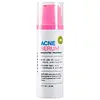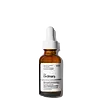What's inside
What's inside
 Key Ingredients
Key Ingredients

 Benefits
Benefits

 Concerns
Concerns

 Ingredients Side-by-side
Ingredients Side-by-side

Salicylic Acid 1.5%
MaskingWater
Skin ConditioningPropanediol
SolventGlycerin
HumectantCaprylic/Capric Triglyceride
MaskingDimethyl Isosorbide
SolventLactobacillus Ferment
Skin ConditioningCoconut Alkanes
EmollientCoco-Caprylate
EmollientNiacinamide
SmoothingCetearyl Alcohol
EmollientBehenyl Alcohol
EmollientCandelilla/Jojoba/Rice Bran Polyglyceryl-3 Esters
EmulsifyingTranexamic Acid
AstringentHexyl Laurate
EmollientGlycine Soja Oil
EmollientC15-19 Alkane
SolventPotassium Azeloyl Diglycinate
Skin ConditioningHydrogenated Polydecene
EmollientGlyceryl Stearate
EmollientCeramide NP
Skin ConditioningCeramide AP
Skin ConditioningBakuchiol
AntimicrobialFucus Spiralis Extract
EmollientTetraselmis Chui Extract
EmollientRhodomyrtus Tomentosa Fruit Extract
HumectantTasmannia Lanceolata Fruit/Leaf Extract
AntioxidantAcetyl Glucosamine
Skin ConditioningHydrolyzed Sodium Hyaluronate
Skin ConditioningZinc Sulfate
AntimicrobialMelia Azadirachta Leaf Extract
Skin ConditioningRosmarinus Officinalis Leaf Extract
AntimicrobialThymus Vulgaris Extract
PerfumingOriganum Vulgare Leaf Extract
Skin ConditioningCentella Asiatica Leaf Extract
Skin ConditioningSilybum Marianum Seed Extract
Skin ConditioningVitex Agnus-Castus Extract
AstringentHelianthus Annuus Extract
EmollientOryza Sativa Bran Extract
Skin ConditioningOryza Sativa Extract
AbsorbentOryza Sativa Germ Extract
EmollientAllantoin
Skin ConditioningPanthenol
Skin Conditioning1,2-Hexanediol
Skin ConditioningSodium Stearoyl Lactylate
EmulsifyingCitric Acid
BufferingXanthan Gum
EmulsifyingPolyglyceryl-3 Diisostearate
EmulsifyingPolyacrylate Crosspolymer-6
Emulsion StabilisingCoco-Caprylate/Caprate
EmollientCaprylhydroxamic Acid
Sodium Phytate
Tocopherol
AntioxidantSodium Benzoate
MaskingPotassium Sorbate
PreservativeBiosaccharide Gum-1
HumectantPhenoxyethanol
PreservativeSodium Levulinate
Skin ConditioningGlyceryl Caprylate
EmollientSodium Anisate
AntimicrobialSalicylic Acid 1.5%, Water, Propanediol, Glycerin, Caprylic/Capric Triglyceride, Dimethyl Isosorbide, Lactobacillus Ferment, Coconut Alkanes, Coco-Caprylate, Niacinamide, Cetearyl Alcohol, Behenyl Alcohol, Candelilla/Jojoba/Rice Bran Polyglyceryl-3 Esters, Tranexamic Acid, Hexyl Laurate, Glycine Soja Oil, C15-19 Alkane, Potassium Azeloyl Diglycinate, Hydrogenated Polydecene, Glyceryl Stearate, Ceramide NP, Ceramide AP, Bakuchiol, Fucus Spiralis Extract, Tetraselmis Chui Extract, Rhodomyrtus Tomentosa Fruit Extract, Tasmannia Lanceolata Fruit/Leaf Extract, Acetyl Glucosamine, Hydrolyzed Sodium Hyaluronate, Zinc Sulfate, Melia Azadirachta Leaf Extract, Rosmarinus Officinalis Leaf Extract, Thymus Vulgaris Extract, Origanum Vulgare Leaf Extract, Centella Asiatica Leaf Extract, Silybum Marianum Seed Extract, Vitex Agnus-Castus Extract, Helianthus Annuus Extract, Oryza Sativa Bran Extract, Oryza Sativa Extract, Oryza Sativa Germ Extract, Allantoin, Panthenol, 1,2-Hexanediol, Sodium Stearoyl Lactylate, Citric Acid, Xanthan Gum, Polyglyceryl-3 Diisostearate, Polyacrylate Crosspolymer-6, Coco-Caprylate/Caprate, Caprylhydroxamic Acid, Sodium Phytate, Tocopherol, Sodium Benzoate, Potassium Sorbate, Biosaccharide Gum-1, Phenoxyethanol, Sodium Levulinate, Glyceryl Caprylate, Sodium Anisate
Water
Skin ConditioningLactococcus Ferment Lysate
Skin ConditioningPropanediol
SolventPotassium Azeloyl Diglycinate
Skin ConditioningCarnitine
CleansingAcetyl Glucosamine
Skin ConditioningSarcosine
Skin ConditioningEctoin
Skin ConditioningAdenosine
Skin ConditioningPolylysine
Silanetriol
Glycerin
HumectantPentylene Glycol
Skin ConditioningSclerotium Gum
Emulsion StabilisingXanthan Gum
EmulsifyingIsoceteth-20
EmulsifyingCitric Acid
BufferingSodium Citrate
BufferingTrisodium Ethylenediamine Disuccinate
Sodium Chloride
MaskingEthylhexylglycerin
Skin ConditioningSodium Benzoate
MaskingPhenoxyethanol
PreservativeChlorphenesin
AntimicrobialWater, Lactococcus Ferment Lysate, Propanediol, Potassium Azeloyl Diglycinate, Carnitine, Acetyl Glucosamine, Sarcosine, Ectoin, Adenosine, Polylysine, Silanetriol, Glycerin, Pentylene Glycol, Sclerotium Gum, Xanthan Gum, Isoceteth-20, Citric Acid, Sodium Citrate, Trisodium Ethylenediamine Disuccinate, Sodium Chloride, Ethylhexylglycerin, Sodium Benzoate, Phenoxyethanol, Chlorphenesin
 Reviews
Reviews

Ingredients Explained
These ingredients are found in both products.
Ingredients higher up in an ingredient list are typically present in a larger amount.
Acetyl Glucosamine is an antioxidant and humectant. It is an amino acid sugar and is naturally found in our skin.
The cool thing about this ingredient? It helps the skin produce hyaluronic acid and boost hydration. It also has antioxidant benefits to protect skin cells.
When paired with niacinamide, Acetyl Glucosamine has been shown to be effective at reducing discoloration.
Learn more about Acetyl GlucosamineCitric Acid is an alpha hydroxy acid (AHA) naturally found in citrus fruits like oranges, lemons, and limes.
Like other AHAs, citric acid can exfoliate skin by breaking down the bonds that hold dead skin cells together. This helps reveal smoother and brighter skin underneath.
However, this exfoliating effect only happens at high concentrations (20%) which can be hard to find in cosmetic products.
Due to this, citric acid is usually included in small amounts as a pH adjuster. This helps keep products slightly more acidic and compatible with skin's natural pH.
In skincare formulas, citric acid can:
While it can provide some skin benefits, research shows lactic acid and glycolic acid are generally more effective and less irritating exfoliants.
Most citric acid used in skincare today is made by fermenting sugars (usually from molasses). This synthetic version is identical to the natural citrus form but easier to stabilize and use in formulations.
Read more about some other popular AHA's here:
Learn more about Citric AcidGlycerin is already naturally found in your skin. It helps moisturize and protect your skin.
A study from 2016 found glycerin to be more effective as a humectant than AHAs and hyaluronic acid.
As a humectant, it helps the skin stay hydrated by pulling moisture to your skin. The low molecular weight of glycerin allows it to pull moisture into the deeper layers of your skin.
Hydrated skin improves your skin barrier; Your skin barrier helps protect against irritants and bacteria.
Glycerin has also been found to have antimicrobial and antiviral properties. Due to these properties, glycerin is often used in wound and burn treatments.
In cosmetics, glycerin is usually derived from plants such as soybean or palm. However, it can also be sourced from animals, such as tallow or animal fat.
This ingredient is organic, colorless, odorless, and non-toxic.
Glycerin is the name for this ingredient in American English. British English uses Glycerol/Glycerine.
Learn more about GlycerinPhenoxyethanol is a preservative that has germicide, antimicrobial, and aromatic properties. Studies show that phenoxyethanol can prevent microbial growth. By itself, it has a scent that is similar to that of a rose.
It's often used in formulations along with Caprylyl Glycol to preserve the shelf life of products.
Potassium Azeloyl Diglycinate (PAD) comes from the condensation of azelaic acid mixed with glycine.
This ingredient has similar properties to azelaic acid; it can help reduce sebum production and soothe skin. PAD also inhibits tyrosinase activity to help brighten skin. Tyrosinase is an enzyme that controls melanin production.
A study from 2023 found 5% PAD combined with nicotinamide (a form of niacin) effectively reduced melanin production after 6 weeks.
Several studies from the 2010's also show PAD to be effective in alleviating symptoms of Rosacea.
Though this ingredient is considered a gentle active, higher amounts may result in irritation.
Unlike azelaic acid, this ingredient is water-soluble. This property makes it easier to formulate into skincare products.
Learn more about Potassium Azeloyl DiglycinatePropanediol is an all-star ingredient. It softens, hydrates, and smooths the skin.
It’s often used to:
Propanediol is not likely to cause sensitivity and considered safe to use. It is derived from corn or petroleum with a clear color and no scent.
Learn more about PropanediolSodium Benzoate is a preservative. It's used in both cosmetic and food products to inhibit the growth of mold and bacteria. It is typically produced synthetically.
Both the US FDA and EU Health Committee have approved the use of sodium benzoate. In the US, levels of 0.1% (of the total product) are allowed.
Sodium benzoate works as a preservative by inhibiting the growth of bacteria inside of cells. It prevents the cell from fermenting a type of sugar using an enzyme called phosphofructokinase.
It is the salt of benzoic acid. Foods containing sodium benzoate include soda, salad dressings, condiments, fruit juices, wines, and snack foods.
Studies for using ascorbic acid and sodium benzoate in cosmetics are lacking, especially in skincare routines with multiple steps.
We always recommend speaking with a professional, such as a dermatologist, if you have any concerns.
Learn more about Sodium BenzoateWater. It's the most common cosmetic ingredient of all. You'll usually see it at the top of ingredient lists, meaning that it makes up the largest part of the product.
So why is it so popular? Water most often acts as a solvent - this means that it helps dissolve other ingredients into the formulation.
You'll also recognize water as that liquid we all need to stay alive. If you see this, drink a glass of water. Stay hydrated!
Learn more about WaterXanthan gum is used as a stabilizer and thickener within cosmetic products. It helps give products a sticky, thick feeling - preventing them from being too runny.
On the technical side of things, xanthan gum is a polysaccharide - a combination consisting of multiple sugar molecules bonded together.
Xanthan gum is a pretty common and great ingredient. It is a natural, non-toxic, non-irritating ingredient that is also commonly used in food products.
Learn more about Xanthan Gum